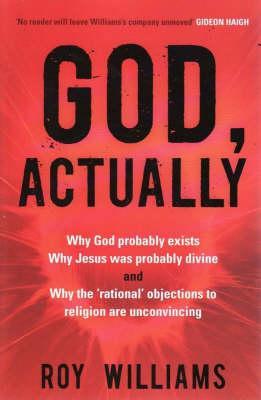This post should be Part 2 of my ‘reviews’ or notes re “God, Actually” by Roy Williams (1).
The subtitle of Roy Williams’ book is “Why God probably exists, Why Jesus was probably divine, and Why the ‘rational’ objections to religion are unconvincing”.
Roy Williams wishes to define a miracle in terms that do not presuppose a god, so embraces English philosopher Brian Davies’ definition of a miracle as
an event that cannot be explained in terms intelligible to the natural scientist or observer of the regular processes of Nature. (p.163)
That’s hardly a very good definition. It would mean that any event that is not currently understood by science is miraculous. It would mean that if Einstein had not been born or no-one had postulated the theory of relativity at the time that a star’s light was seen to actually bend around the sun at the time of an eclipse, then that bending of starlight would have to be defined as even more miraculous than the bending of Uri Geller’s spoon. Did lightning only cease to be a miracle after the discovery of electricity? The role of science has been to uncover natural explanations for things that once could not be explained naturally. Still a wee way to go too.
Roy Williams distils David Hume’s argument against the possibility of a true miracle being honestly reported into four points (p.165):
- no such testimony has ever been given by enough people of adequate learning and intelligence;
- people are naturally gullible and untrustworthy;
- reports of miracles tend to emanate from ‘ignorant and barbarous nations’;
- and different religions report different miracles, and this invalidates all such reports.
Of the first three points Williams writes:
they amount to saying that no human observer can ever be completely trusted. This seems to me a cynical generalisation, a prime example of reductionism.
With this dismissal, Roy Williams’ dismisses David Hume from the remainder of his discussion of miracles, apart from a later section where he treats point 4 separately.
Williams depicts David Hume’s scepticism as extremist and even unnatural in its relationship to the rest of humanity. My own scepticism has been accompanied by a deeper sense of affinity with the rest of human kind, and David Hume’s argument never struck me as so cynical. Compare Roy Williams’ rationalization for dismissing David Hume with what Hume actually wrote in his famous section on miracles:
. . . we may observe, that there is no species of reasoning more common, more useful, and even necessary to human life, than that which is derived from the testimony of men, and the reports of eye-witnesses and spectators. . . . It will be sufficient to observe that our assurance in any argument of this kind is derived from no other principle than our observation of the veracity of human testimony, and of the usual conformity of facts to the reports of witnesses.
Far from coming within two miles of even suggesting that “no human observer can ever be completely trusted”, Hume flatly states from the start that acceptance of eye-witness testimony is the most common, useful and even necessary of “species of reasoning” we all have.
Were not the memory tenacious to a certain degree; had not men commonly an inclination to truth and a principle of probity; were they not sensible to shame, when detected in a falsehood: were not these, I say, discovered by experience to be qualities, inherent in human nature, we should never repose the least confidence in human testimony. A man delirious, or noted for falsehood and villainy, has no manner of authority with us.
There is no room in the passage from David Hume for Roy Williams to dismiss his writing as a “cynical generalization” against the normal course of eyewitness testimony of fellow human beings. On the contrary, Hume begins with “the charitable” position that most people are generally inclined to tell the truth about what they witness throughout life. Most people, Hume asserts, have no wish to be disgraced by being found out to be liars.
This passage from David Hume pulls the rug from beneath Roy Williams’ reasons for dismissing Hume’s arguments, and obliges Williams to seriously return to engage with the detail of Hume’s actual argument.
So if Hume asserts that it is natural and necessary to rely on eyewitness testimony as a general rule, under what circumstances does Hume then open the way to doubting others? He explains:
We entertain a suspicion concerning any matter of fact, when the witnesses contradict each other; when they are but few, or of a doubtful character; when they have an interest in what they affirm; when they deliver their testimony with hesitation, or on the contrary, with too violent asseverations. There are many other particulars of the same kind, which may diminish or destroy the force of any argument, derived from human testimony.
So how does Hume treat accounts of miracles in books that have a reputation of being authored by historians, or even just from any person with a reputation for being of good character?
The reason why we place any credit in witnesses and historians, is not derived from any connexion, which we perceive a priori, between testimony and reality, but because we are accustomed to find a conformity between them.
Hume argues that the reason we tend to believe historians and others is because our experiences have conditioned us to expecting them to tell the facts.
But when the fact attested is such a one as has seldom fallen under our observation, here is a contest of two opposite experiences; of which the one destroys the other, as far as its force goes, and the superior can only operate on the mind by the force, which remains.
But if an historian or otherwise honourable person proclaims a miracle, then our experience that miracles do not happen is enough to alert us that in this case the otherwise trustworthy person is mistaken. Hence most readers of Josephus today may take many of his details of the history of the Jewish war as factual, but will not treat his reports of miracles as having the same level of credibility. Similarly ancient historians like Herodotus and Livy pass on many historical details that we are at liberty to assume as factual, but no-one embraces their tales of miracles with the same certainty.
Hume argues for consistency:
The very same principle of experience, which gives us a certain degree of assurance in the testimony of witnesses, gives us also, in this case, another degree of assurance against the fact, which they endeavour to establish; from which contradiction there necessarily arises a counterpoize, and mutual destruction of belief and authority.
The reason we generally accept certain information from historians as factual is the same reason we dismiss their reports of miracles.
Many fundamentalists and other Christians who dismiss the miracles in pagan histories yet believe in the Bible’s miracles are being inconsistent. They treat the “facts” in pagan histories as historical for the same reason most people do — readers are accustomed to finding correlations between the writings of historians and true facts. And they find it as easy as any sceptic to dismiss as untrue any event (a miracle) that goes against their experience of nature and the world. But they treat the Bible differently (as a book whose words are permitted to assume greater authority than our own personal experiences) and therefore the miracles of the Bible must be accepted.
David Hume does not write cynically or with sweeping generalization against the trustworthiness of people. I have quoted his writings on how he approaches normal eyewitness testimony to show that he is hardly a reductionist (as Williams suggests).
In the first part of his essay on miracles Hume presented the rational argument against believing in them. In the second part of his essay he discusses four reasons for disbelieving the testimony that does exist for miracles. Williams dot-pointed these 4 (above) and Hume’s discussion of each of them can be found in part 2 of his essay.
Disappointingly, after dismissing David Hume’s scepticism as cynical and reductionist, Williams discusses the miracles of Jesus as if they are known to us all from multitudes of eyewitnesses. Of course, we only have four gospels, with at least two and very likely three all largely mutations from the original one (GMark) — not multitudes of eyewitnesses at all. The fact that one author wrote a story about multitudes of witnesses, and that that story was modified by others, and that it was not testified till the second century c.e., is scarcely credible evidence for miracles being performed a century earlier. We have more reason to believe the historian Tacitus who “reported” miracles by the emperor Vespasian within a decade or two of his lifetime.
But I will leave the last word to Roy Williams here and leave it to readers to ask the obvious follow up questions it leaves hanging. Roy Williams argues against Hume’s fourth point as follows:
My own view is that the consistency of such reports through human history is suggestive that miracles do — rarely — occur. Has the Catholic Church always been wrong when, as a precondition to conferring sainthoods, it has accepted reports of miracles? I doubt it. (p.293)






